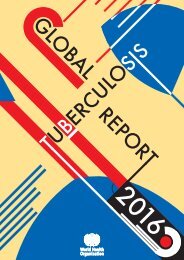patients
DNDi_AR_2015
DNDi_AR_2015
You also want an ePaper? Increase the reach of your titles
YUMPU automatically turns print PDFs into web optimized ePapers that Google loves.
HUMAN AFRICAN TRYPANOSOMIASIS / SLEEPING SICKNESS<br />
R&D MODEL & PORTFOLIO<br />
DEVELOPMENT<br />
Fexinidazole<br />
PROJECT START: April 2007<br />
OVERALL OBJECTIVE: Develop and register fexinidazole as a new<br />
oral drug for the treatment of HAT caused by T. b. gambiense<br />
(g-HAT), ideally also to be used for T. b. rhodesiense (r-HAT)<br />
2015 OBJECTIVES:<br />
• Complete recruitment of the pivotal Phase II/III study of<br />
fexinidazole versus the reference treatment (NECT)<br />
• Complete recruitment of the studies in adults with stage 1/early<br />
stage 2 g-HAT and in children above 6 years of age and over 20 kg<br />
weight (both stages)<br />
749 <strong>patients</strong><br />
recruited at 10 sites<br />
Fexinidazole, the result of successful<br />
compound-mining efforts pursued<br />
by DNDi in 2005, entered clinical<br />
development in September 2009 and is being co-developed<br />
with Sanofi: DNDi is undertaking clinical and pharmaceutical<br />
development whilst Sanofi is responsible for the industrial<br />
development and production. Fexinidazole is the most advanced<br />
oral candidate under development for HAT. DNDi aims to<br />
evaluate and register it as a treatment for a wide range of<br />
<strong>patients</strong>, specifically in adults and children over 6 years of age<br />
and 20 kg body weight with either stage of disease.<br />
The pivotal study compares fexinidazole in <strong>patients</strong> with<br />
late stage g-HAT versus NECT, and completed inclusions<br />
of all 394 <strong>patients</strong> between October 2012 and April 2015.<br />
The 18 month follow-up period will end in 2016, and results<br />
processed for regulatory submission in Q3 2017. Additional<br />
safety and efficacy data from the two complementary studies<br />
will also be included; the first reached 230 early stage<br />
adult <strong>patients</strong> and the second 125 children aged 6-14 years<br />
(approximately equal numbers of early stage and late stage<br />
<strong>patients</strong>) in an open, non-comparative study, using the same<br />
regimen with doses adapted to children’s weight. In total<br />
therefore, information collected from 749 individuals will be<br />
included in the safety database.<br />
More information from special population groups not included<br />
in trials to date, such as pregnant and breastfeeding women,<br />
<strong>patients</strong> with poor nutritional status or with chronic diseases,<br />
will be obtained in a planned Phase IIIb trial. This will also<br />
include a cohort of out<strong>patients</strong> and will provide preliminary<br />
information about treatment compliance and use on an<br />
outpatient basis.<br />
The protocol for a study to be undertaken in r-HAT <strong>patients</strong> is<br />
being finalized, sites in Uganda and Malawi have been identified,<br />
and the study is planned to commence in 2017.<br />
The submission of a regulatory dossier to the European<br />
Medicines Agency (EMA) under Article 58 is planned for 2017,<br />
for the treatment of g-HAT with fexinidazole. This provision<br />
allows the EMA’s Committee for Medicinal Products for Human<br />
Use (CHMP) to give scientific opinions, in co-operation with<br />
the World Health Organization (WHO), on drugs to prevent or<br />
treat diseases of major public health interest and intended<br />
exclusively for markets outside the European Union. It aims to<br />
ensure faster WHO prequalification of medicines by removing<br />
barriers to simultaneous prequalification. A Risk Management<br />
Plan to further monitor safety and efficacy in the field is under<br />
preparation in collaboration with Sanofi and WHO.<br />
PARTNERS: Sanofi, France; Swiss Tropical and Public Health<br />
Institute (Swiss TPH), Switzerland; Institute of Tropical Medicine<br />
(ITM) – Antwerp, Belgium; Médecins Sans Frontières; Institut de<br />
Recherche pour le Développement (IRD), France; Institut National<br />
de Recherche Biomédicale (INRB), DRC; HAT Platform; National<br />
Control Programmes of the Democratic Republic of Congo and the<br />
Central African Republic.<br />
IMPLEMENTATION<br />
NECT: Nifurtimox-Eflornithine<br />
Combination Therapy<br />
PROJECT START: May 2004<br />
OVERALL OBJECTIVE: Develop and make available a safe, effective,<br />
easier to administer and more cost-effective combination therapy<br />
which requires shorter hospitalization<br />
2015 OBJECTIVE: Prepare the field for change of policy and<br />
implementation<br />
365 NECT kits<br />
distributed,<br />
sufficient to treat<br />
1,460 <strong>patients</strong><br />
NECT, a co-administration of intravenous<br />
eflornithine and oral nifurtimox, was<br />
developed by Epicentre, MSF, DNDi,<br />
Swiss TPH, and the national HAT control<br />
programmes of the Republic of the Congo<br />
and DRC. After inclusion in the WHO Essential Medicines<br />
List in 2009, it quickly became the first-line treatment for<br />
second stage g-HAT. NECT has been a game-changer in the<br />
treatment of sleeping sickness – it has reduced the number of<br />
eflornithine infusions required, compared to when it is used<br />
as a monotherapy, from 56 to 14. More importantly, however,<br />
it has had a major impact on <strong>patients</strong>, by removing the fear<br />
of treatment they had when the only option was melarsoprol,<br />
a product so toxic that it killed up to 5% of all <strong>patients</strong> who<br />
received it. NECT is available in all endemic countries, who<br />
receive free supplies from WHO via drug donations by Sanofi<br />
and Bayer.<br />
In 2015, 365 NECT kits containing four treatments each were<br />
distributed in all disease endemic countries, sufficient to treat<br />
1,460 <strong>patients</strong> with second stage g-HAT.<br />
MAIN PARTNERS: Epicentre, France; Médecins Sans Frontières (MSF),<br />
Holland; Swiss Tropical and Public Health Institute (Swiss TPH),<br />
Switzerland; Ministry of Health, Republic of Congo; HAT Platform;<br />
National Trypanosomiasis Control Programme, DRC<br />
DNDi Annual Report 2015 › 25



